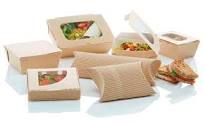 Packaging is a critical part of product development. Do you know that most purchasing decisions are made right on the shelves of supermarkets and other retail outlets? How your product “grabs” the buyers and potential buyers is a function of packaging and labelling.
Packaging is a critical part of product development. Do you know that most purchasing decisions are made right on the shelves of supermarkets and other retail outlets? How your product “grabs” the buyers and potential buyers is a function of packaging and labelling.
The package is your product’s”face to the world” and buyers everywhere demand that the “face” they see and buy does not only combine good design and colors but also conforms with high standards relating to hygiene, energy and the environment.
Philippine food processors and exporters need to satisfy these high standards in their packaging in order to survive and grow in global and even in the upscale local markets.
Here are some packaging tips from Package Machinery Company Inc.
Functions of packaging
There are four primary functions of packaging that need to be addressed when launching new products: product protection, product safety, product freshness, and brand identity.
Product protection
The packaging industry is always seeking innovative packaging solutions to insure your product needs to get from your facility to the consumer in the same condition as when it left your facility – fresh and intact. In order to protect your product throughout the supply chain, this requires close consideration of your primary packaging – or materials used to package the individual, salable unit – and secondary packaging – materials, typically corrugated box or pallet wrap, used to bundle several individual products for shipment and / or displays.
Common packaging solutions include materials such as glass, rigid and flexible plastic, aluminum, and cardboard, sometimes in combination. These are each preferred for specific food applications, but there is overlap.
For example:
- Bag-in-box packaging applications are used for both food (cereal) and beverages (wine)
- Aluminum is suited for cans of soda and to give food containers a premium look and feel.
Product safety
From juices to peanut butter, food and beverage recalls that made the headlines in recent years have brought food safety to the forefront of the consumer’s mind. A product recall can potentially destroy a brand’s credibility, reduce product sales, and possibly result in a lawsuit.
Food product contamination can occur at any point in the supply chain.
As your food or beverage company begins to grow, it is critical to maintain control over your supply chain. There are several packaging processes and technologies designed to help increase food safety measurements. While using food grade materials is a must, there are still hazards that can occur at the packaging stage. For example, inks and coatings used on packaging can migrate into food and beverage products.
For consumer protection, there are labeling laws and regulations that require certain information to be included on food and beverage packaging such as: an ingredient list, possible effects of consumption or use, the batch ID and date of manufacture so the product can be traced or discarded at expiration.
Product freshness
The freshness of a product increases with the right packaging, helping appearance, taste, shelf life and quality.
Regardless of how good your food or beverage product’s recipe is, if it doesn’t taste fresh, chances are you will lose your customrs. With packaged goods, the time from when your product is made until the time it is consumed can vary from days to years. The date used on a package is usually a ‘sell by date’. However, because the consumer often keeps a product at home for a period of time before consuming it, it’s important the packaging helps maintain freshness beyond the sell by date.
There are tested and new packaging technology advancements allowing for food manufacturers to extend a product’s shelf life and better control product freshness including:
o Materials – flexible packaging such as flow wrapped candy bars will have a much longer shelf life than foil and paper packaged ones. There is a trade off in consumer expectation for flow wrapped candy, so both cost and appearance need consideration.
o Film barriers – In flexible packaging, there are different barrier properties for air, moisture, and flavor. Coatings can be added to films to change and extend the product’s shelf life and enhance freshness. Some foods and beverages require a barrier. Some, such as meat products, require breathability in their wrap.
o Resealable packaging – typically in the form of a zipper, lid or label closure, resealable packaging helps maintain product freshness by locking out air and adds convenience for the consumer.
Resealability is a great option for products meant to be consumed over multiple times.
Brand identity
Packaging has become an essential part of the marketing mix and allows you to communicate product information directly with the consumer.
Fundamentally, a good package design will attract the consumer’s attention and it will protect the product from processing through consumption. Using the right size, shape, colors and materials in your packaging will enhance the consumer’s experience with your product which, ultimately, will help build brand awareness.
If you have the resources, consider hiring a packaging designer who can help create a unique brand identity as well as help determine materials suitable for your products. However, if your budget is limited, there are cost-effective options and you can always modify your packaging (or rebrand your product) as time goes on.
Photo credits: https://hq.scis-his.net/gin2016/index.php/workshop-2
